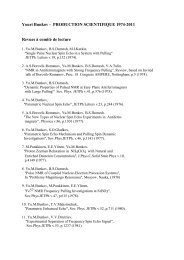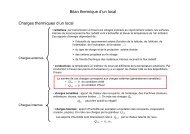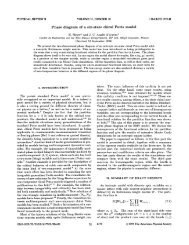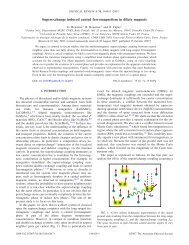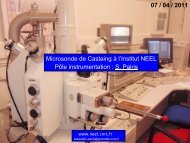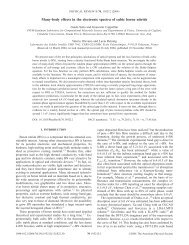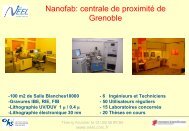Activity Report 2010 - CNRS
Activity Report 2010 - CNRS
Activity Report 2010 - CNRS
Create successful ePaper yourself
Turn your PDF publications into a flip-book with our unique Google optimized e-Paper software.
SCIENTIFIC REPORT<br />
FURTHER READING:<br />
Phys. Rev. B (2011) - accepted<br />
Thermoelectric transport properties of<br />
silicon: Towards an ab initio approach<br />
Appl. Phys. Lett. 94, 203109 (2009).<br />
Improved thermoelectric properties of<br />
Mg 2Si xGe ySn 1-x-y nanoparticle in alloy<br />
materials.<br />
Photovoltaic, in particular for organic<br />
systems or for molecular photochemical<br />
system (where the energy conversion<br />
takes place in a single molecule),<br />
represents also a new orientation with an<br />
interesting synergy among theorists of<br />
simulation. It actually appears that all<br />
competences needed to tackle the four<br />
aspects of a photovoltaic device (as<br />
described in Figure 3) are present among<br />
NanoSTAR project members.<br />
Fig. 3: The different steps of a photovoltaic<br />
device with a pn junction.<br />
Chair of Excellence <strong>2010</strong>: Harold<br />
BARANGER<br />
Coordinator: Mireille LAVAGNA<br />
(INAC/SPSMS).<br />
The so-called CORTRANO project focuses<br />
on novel correlations that can be probed<br />
in nanoscale systems, and their influence<br />
on electronic transport or other nonequilibrium<br />
observables. A strong link<br />
between computational, analytical and<br />
model approaches will be implemented to<br />
tackle several problems in this field, i.e<br />
steady-state quantum transport,<br />
correlation and conductance in strongly<br />
inhomogeneous low-density electron gas<br />
or correlations induced on the fly by<br />
localized impurities in particular in the<br />
Josephson junction context.<br />
Thermal properties<br />
“New comers” Project 2007: Natalio<br />
MINGO (Liten)<br />
Post-doc fellow: Shidong WANG<br />
Thermal properties and in particular heat<br />
conduction are important in the contexts<br />
of electronics (heat dissipation) and<br />
energy conversion (thermoelectric<br />
devices).<br />
This project’s challenge precisely consists<br />
in mastering thermal properties of such a<br />
system.<br />
In the context of thermoelectric<br />
applications the aim is to get a system<br />
which behaves simultaneously as a<br />
crystal for electrons and as a glass for<br />
phonons. Different systems have been<br />
studied to reduce heat conduction<br />
without destroying electrical conduction<br />
in order to get a good factor of merit Z.<br />
One of the strategies employed here is to<br />
introduce nanoparticle or produce<br />
nanocomposites to obtain ‘NEAT’<br />
materials (‘Nanoparticle Embedded in<br />
Alloy Thermoelectric’ materials).<br />
(see Figure 4).<br />
For example simulation showed that<br />
Mg 2 Si x Ge y Sn 1-x-y alloys with embedded<br />
Mg 2 Si nanoparticles are promising<br />
thermoelectrics to be operated at<br />
intermediate temperature. A design of a<br />
new thermoelectric device based on semi<br />
randomly dispersed wires has also been<br />
proposed. This is the object of a patent<br />
application. The invention allows to<br />
considerably simplifying the fabrication<br />
procedure for planar thermoelectric<br />
devices. Shidong WANG, the postdoctoral<br />
fellow employed by the<br />
Foundation as part of this project,<br />
performed calculations to assess the<br />
robustness of the approach as well as its<br />
feasibility.<br />
Please read the corresponding Highlight<br />
at the end of this report for further<br />
information<br />
Fig. 4: The heat conduction and thermoelectric properties of system (here SiGe) can be modified<br />
by introducing nanodots which scatter phonons and reduce heat conductivity.<br />
34



